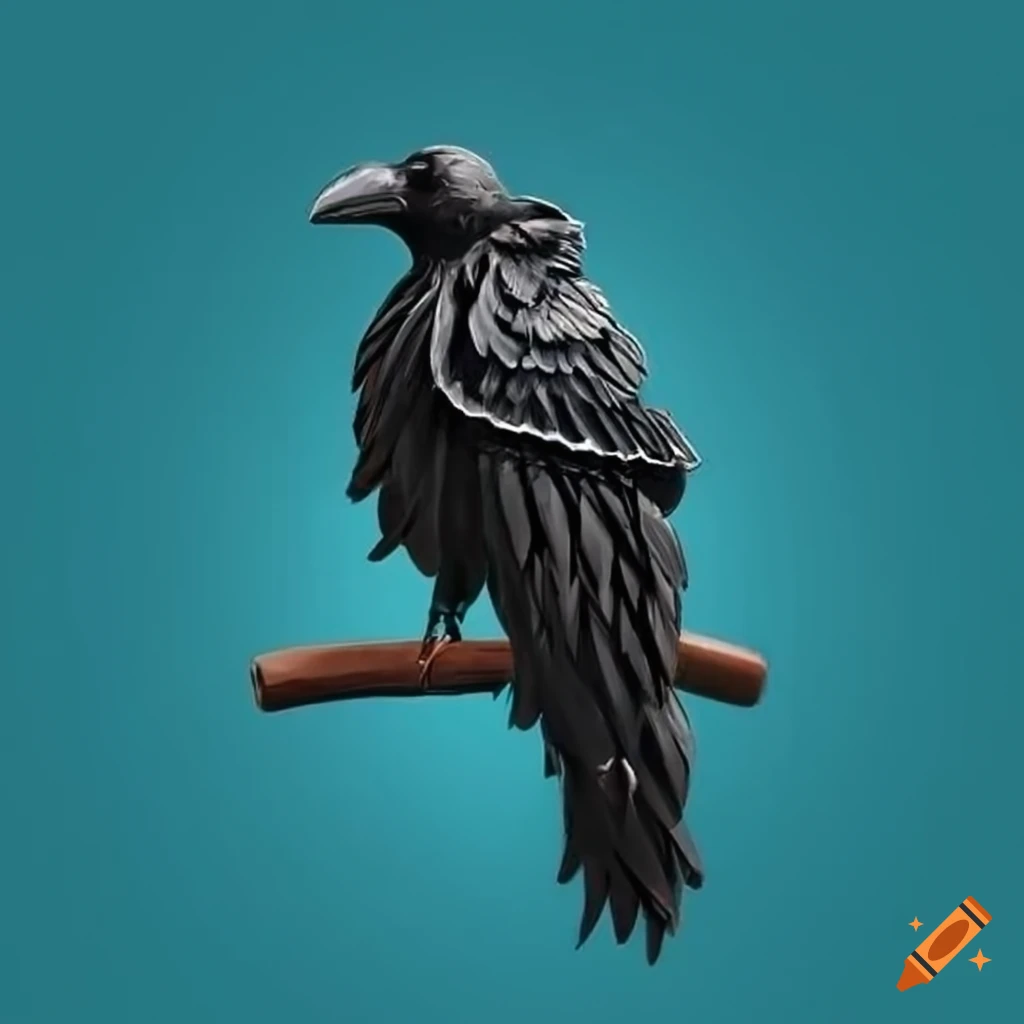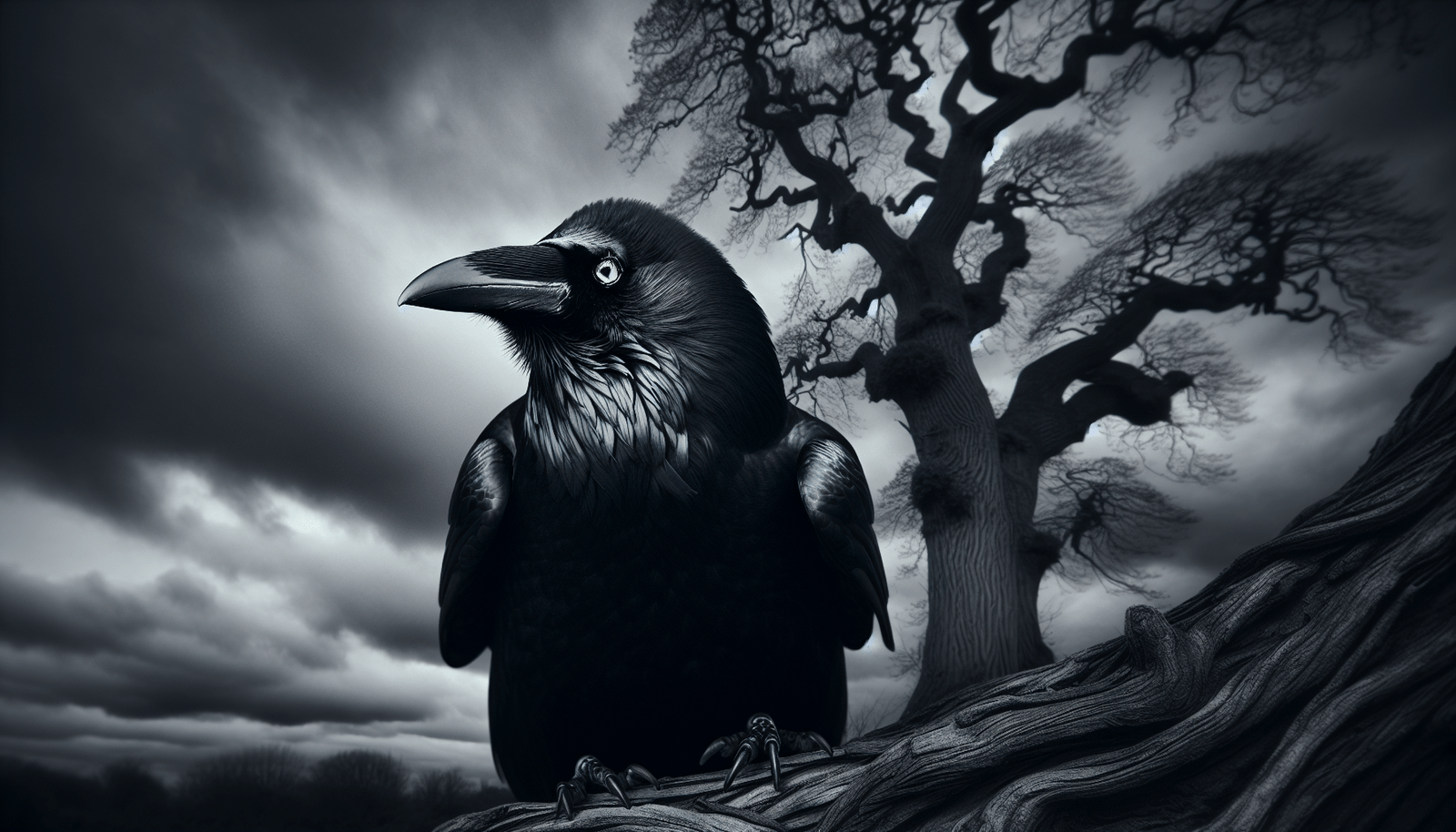Discovering the Palawan Crow: The Fascinating Corvus Pusillus Tweeddale
December 29, 2023 | by BlackCrow.com

The Palawan Crow: An Introduction
The Palawan Crow, scientifically known as Corvus pusillus tweeddale, 1878, is a fascinating species of black crow found in the Palawan province of the Philippines. In this section, we will provide an overview of the Palawan Crow and delve into its taxonomy and scientific classification.
Overview of the Palawan Crow
The Palawan Crow is a medium-sized bird known for its glossy black feathers and distinct features. It belongs to the Corvidae family, which includes other intelligent and sociable birds such as the Pied Crow, White-necked Raven, and American Crow. While its appearance may resemble other crow species, the Palawan Crow possesses unique characteristics that set it apart.
This species has adapted to the diverse ecosystems found in Palawan, including lowland forests, mangroves, and coastal areas. It plays a significant role in the local ecosystem by contributing to seed dispersal and insect control. However, the Palawan Crow faces various conservation challenges, making it a species of interest for researchers and conservationists.
Taxonomy and Scientific Classification
The Palawan Crow is classified under the following taxonomy:
- Kingdom: Animalia
- Phylum: Chordata
- Class: Aves
- Order: Passeriformes
- Family: Corvidae
- Genus: Corvus
- Species: Corvus pusillus
- Subspecies: Corvus pusillus tweeddale, 1878
Understanding the scientific classification of the Palawan Crow helps researchers and bird enthusiasts identify its relationship with other bird species. It is essential to note that taxonomy and classification may undergo revisions as new research and discoveries emerge.
To learn more about other species within the Corvidae family, you can explore our articles on Pied Crow, White-necked Raven, and American Crow.
The Palawan Crow’s unique characteristics, distribution, behavior, and conservation status will be explored in detail in the subsequent sections of this article.
Physical Characteristics and Distribution
The Palawan Crow, scientifically known as Corvus pusillus Tweeddale, is a fascinating bird with unique physical characteristics. This section will provide a detailed description of the Palawan Crow and explore its distribution and habitat.
Description of the Palawan Crow
The Palawan Crow is a medium-sized bird belonging to the Corvidae family. It measures approximately 42 to 46 centimeters (16.5 to 18 inches) in length and has a wingspan of about 85 centimeters (33 inches). The plumage of the Palawan Crow is predominantly black, with a glossy appearance. It features a robust and slightly curved bill, which is an important adaptation for its feeding habits.
One distinguishing characteristic of the Palawan Crow is its white eyes, which contrast with its black feathers. This feature sets it apart from other members of the crow family. Additionally, the Palawan Crow has strong legs and feet, designed for perching and walking on various types of surfaces.
Distribution and Habitat
The Palawan Crow is endemic to the island of Palawan in the Philippines, making it a special and unique species. Its range is limited to this specific region, where it inhabits a variety of habitats, including forests, woodlands, and coastal areas. The Palawan Crow can be found at different elevations, from sea level to higher mountainous regions.
Within its habitat, the Palawan Crow exhibits adaptability, enabling it to thrive in various ecological niches. It is often observed in small groups or family units, foraging for food both on the ground and in the trees. The availability of abundant food resources, such as fruits, insects, small vertebrates, and carrion, contributes to the success of the Palawan Crow population.
Efforts should be made to preserve the natural habitats of the Palawan Crow and protect it from the threats it faces. By understanding the physical characteristics and distribution of this fascinating bird, we can appreciate its unique qualities and contribute to the conservation of its population.
Behavior and Diet
Understanding the behavior and dietary preferences of the Palawan Crow is essential to gaining insight into this fascinating bird species.
Social Behavior of Palawan Crows
Palawan Crows are highly social birds, often seen in small to large flocks. They exhibit cooperative behavior within their groups, engaging in activities such as foraging, roosting, and even defending their territory together. These crows are known for their intelligence and problem-solving abilities, which they utilize during various social interactions.
Within the flock, Palawan Crows establish a dominance hierarchy, with more dominant individuals having priority access to resources and mates. They communicate through a range of vocalizations, including calls, caws, and complex vocal patterns. Their vocalizations play a crucial role in maintaining social bonds and coordinating group activities.
Feeding Habits and Diet
Palawan Crows have an omnivorous diet, which allows them to adapt to various food sources found in their habitat. They primarily feed on fruits, seeds, insects, small vertebrates, and even carrion. Their powerful beaks are well-suited for cracking open nuts and seeds, while their keen eyesight helps them detect prey during foraging.
These crows are opportunistic feeders, taking advantage of available food sources in their environment. They are known to scavenge and steal food from other birds and animals. Palawan Crows are also skilled at using tools, such as sticks or twigs, to extract food from crevices or manipulate objects.
Understanding the behavior and diet of Palawan Crows provides valuable insights into their ecological role and adaptations. By studying their social interactions and feeding habits, researchers can gain a better understanding of their conservation needs and contribute to their long-term survival.
For more information on other crow species, check out our articles on pied crow, white-necked raven, American crow, little crow, or northwestern crow.
Conservation Status and Threats
Understanding the conservation status and threats faced by the Palawan Crow is crucial in ensuring the preservation of this fascinating bird species.
Current Conservation Status
The Palawan Crow (Corvus pusillus tweeddale, 1878) is a species of crow endemic to the island of Palawan in the Philippines. It is classified as “Vulnerable” by the International Union for Conservation of Nature (IUCN). The population of Palawan Crows is estimated to be less than 10,000 mature individuals. The decreasing trend in their population raises concerns about their long-term survival.
Threats to the Palawan Crow Population
The Palawan Crow faces various threats that contribute to its vulnerable status. These threats include:
-
Habitat Loss: The primary threat to the Palawan Crow is habitat loss due to deforestation and conversion of land for agriculture, urbanization, and infrastructure development. The destruction of its natural habitat reduces the available nesting and foraging areas for the species.
-
Hunting and Trapping: The Palawan Crow is sometimes hunted for food or captured for the illegal pet trade. This human activity negatively impacts the population, especially when it occurs in significant numbers.
-
Invasive Species: The introduction of invasive species, such as predators and competitors, poses a threat to the Palawan Crow. These invasive species may outcompete the crow for resources or prey upon their eggs and nestlings.
-
Climate Change: The effects of climate change, including rising temperatures and changes in rainfall patterns, can disrupt the Palawan Crow’s habitat and food availability. These changes may affect the crow’s breeding success and overall population.
Conservation efforts are vital for the protection and preservation of the Palawan Crow. Initiatives aimed at mitigating these threats and promoting habitat conservation are essential for the long-term survival of this unique bird species. To learn more about similar conservation efforts for other crow species, visit our article on black crow conservation.
By understanding the current conservation status and identifying the threats to the Palawan Crow population, conservationists can work towards implementing effective strategies and monitoring programs to safeguard this remarkable bird species.
Conservation Efforts
Preserving the population of the Palawan Crow is of utmost importance due to its limited range and vulnerability. Efforts are being made to ensure the long-term survival of this unique bird species through various conservation initiatives.
Initiatives for Palawan Crow Conservation
To protect the Palawan Crow, several conservation organizations and local authorities have implemented initiatives focused on habitat preservation, research, and education. These initiatives aim to raise awareness about the importance of conserving the Palawan Crow and its habitat among local communities and stakeholders. Some key initiatives include:
-
Habitat Protection: Efforts are underway to safeguard the natural habitat of the Palawan Crow. This involves advocating for the establishment of protected areas and the enforcement of regulations to prevent habitat destruction and disturbance.
-
Research and Monitoring: Ongoing research projects are conducted to gather essential data on the population size, distribution, and behavior of the Palawan Crow. This information helps in understanding the species’ ecological requirements and guides conservation strategies.
-
Community Engagement: Engaging with local communities is crucial for successful conservation. Conservation organizations collaborate with communities living near the Palawan Crow’s habitat to promote sustainable practices and raise awareness about the importance of preserving the bird and its environment.
-
Conservation Breeding Programs: Captive breeding programs are being established to safeguard the Palawan Crow population. These programs aim to increase the number of individuals and provide a safety net against potential threats to the wild population.
Future Prospects for Conservation
Despite the challenges, there is hope for the conservation of the Palawan Crow. Continued efforts and the implementation of effective conservation strategies can contribute to the long-term survival of the species. Some key prospects for conservation include:
-
Habitat Restoration: Restoration projects can help rehabilitate degraded habitats and create suitable conditions for the Palawan Crow. Restoring vegetation and ensuring the availability of food sources are essential for the species’ survival.
-
Collaborative Conservation: Collaboration between local communities, conservation organizations, and government agencies is vital for the success of conservation efforts. Working together ensures a coordinated approach and promotes shared responsibility for the protection of the Palawan Crow.
-
Public Awareness and Education: Educating the public, especially local communities and visitors, about the importance of the Palawan Crow’s conservation is crucial. Enhancing awareness through educational campaigns and outreach programs can foster a sense of stewardship towards the bird and its habitat.
-
Legislation and Policy Support: Strengthening legal frameworks and policies that protect the Palawan Crow and its habitat is essential. Advocacy efforts can help ensure the enforcement of regulations that safeguard the species and its environment.
The future of the Palawan Crow depends on the collective efforts of individuals, organizations, and authorities committed to its conservation. By implementing effective conservation measures and raising awareness, the Palawan Crow can thrive in its unique habitat for generations to come.
Exploring the Palawan Crow: Corvus Pusillus Tweeddale, 1878
The Palawan Crow, scientifically known as Corvus pusillus Tweeddale, 1878, is a fascinating bird species native to the island of Palawan in the Philippines. Let’s delve into the details of this unique crow.
Overview of the Palawan Crow
The Palawan Crow is a member of the Corvidae family, which includes other crow species such as the American Crow, Pied Crow, and Australian Raven. It is a medium-sized crow with distinct physical features and behaviors that distinguish it from other members of the family.
Taxonomy and Scientific Classification
Scientifically classified as Corvus pusillus Tweeddale, 1878, the Palawan Crow belongs to the following taxonomic hierarchy:
- Kingdom: Animalia
- Phylum: Chordata
- Class: Aves
- Order: Passeriformes
- Family: Corvidae
- Genus: Corvus
- Species: Corvus pusillus
The Palawan Crow has its own unique taxonomic identification, allowing researchers and bird enthusiasts to study and understand its specific characteristics.
Moving forward, we will explore the physical characteristics, distribution, behavior, diet, conservation status, and conservation efforts related to the Palawan Crow. Stay tuned for an in-depth understanding of this captivating bird species.
Internal links:
- corvus albus müller, pls, 1776 – pied crow (central african coasts to southern africa)
- corvus albicollis latham, 1790 – white-necked raven or cape raven (southern, central, and eastern africa)
- corvus brachyrhynchos brehm, cl, 1822 – american crow (the united states, southern canada and northern mexico)
- corvus bennetti north, 1901 – little crow (australia)
- corvus caurinus – northwestern crow (the olympic peninsula to southwestern alaska)
- corvus capensis lichtenstein, mhc, 1823 – cape crow or cape rook (east and southern africa)
- corvus corax linnaeus, 1758 – common raven or northern raven (the holarctic regions of the northern hemisphere)
- corvus cornix linnaeus, 1758 – hooded crow (northern and eastern europe and northern africa)
- corvus coronoides vigors & horsfield, 1827 – australian raven (eastern and southern australia)
- corvus corone linnaeus, 1758 – carrion crow (eurasia)
- corvus crassirostris rüppell, 1836 – thick-billed raven (ethiopia)
- corvus cryptoleucus couch, 1854 – chihuahuan raven (southwestern united states and northwestern mexico)
- corvus culminatus sykes, 1832 – indian jungle crow (india and sri lanka)
- corvus enca (horsfield, 1821) – slender-billed crow (malaysia, the philippines, borneo, indonesia)
- corvus edithae lort phillips, 1895 – somali crow (eastern africa)
- corvus florensis büttikofer, 1894 – flores crow (flores, indonesia)
- corvus frugilegus linnaeus, 1758 – rook (eurasia, introduced to new zealand)
- corvus fuscicapillus gray, gr, 1859 – brown-headed crow (new guinea)
- corvus hawaiiensis peale, 1849 (formerly c. tropicus) – hawaiian crow (hawaii)
- corvus imparatus peters, jl, 1929 – tamaulipas crow (gulf of mexico coast of texas and northeastern mexico)
- corvus insularis heinroth, 1903 – bismarck crow (bismark archipelago, papua new guinea)
- corvus jamaicensis gmelin, jf, 1788 – jamaican crow (jamaica)
- corvus kubaryi reichenow, 1885 – mariana crow or aga (guam and rota, northern mariana islands)
- corvus leucognaphalus daudin, 1800 – white-necked crow (hispaniola)
- corvus levaillantii lesson, rp, 1831 – eastern jungle crow (indian subcontinent to the northern malay peninsula)
- corvus meeki rothschild, 1904 – bougainville crow or solomon islands crow (bougainville island and shortland islands, solomon islands)[1]
- corvus macrorhynchos wagler, 1827 – large-billed crow (himalayas, east asia, the malay peninsula, sunda islands, and the philippines)
- corvus minutus gundlach, 1852 – cuban palm crow (cuba) (formerly conspecific with the hispaniolan palm crow)
- corvus mellori mathews, 1912 – little raven (southeastern australia)
- corvus moneduloides lesson, rp, 1831 – new caledonian crow (new caledonia)
- corvus nasicus temminck, 1826 – cuban crow (cuba, isla de la juventud, turks and caicos islands)
- corvus orru bonaparte, 1850 – torresian crow or australian crow (australia, new guinea, lesser sunda islands)
- corvus ossifragus wilson, a, 1812 – fish crow (eastern united states coast)
- corvus palmarum württemberg, 1835 – hispaniolan palm crow (hispaniola) (formerly conspecific with cuban palm crow)
- corvus rhipidurus hartert, ejo, 1918 – fan-tailed raven (eastern africa, middle east)
- corvus ruficollis lesson, rp, 1831 – brown-necked raven (north africa, arabian peninsula, iran, central asia, pakistan)
- corvus sinaloae davis, li, 1958 –– sinaloa crow (pacific coast of mexico)
- corvus samarensis steere, 1890 – small crow (samar and mindanao, philippines)
- corvus splendens vieillot, 1817 – house crow or indian house crow (indian subcontinent, southeast asia, middle east, eastern africa)
- corvus tasmanicus mathews, 1912 – forest raven or tasmanian raven (tasmania and adjacent southern coast of australia)
- corvus torquatus lesson, rp, 1831 – collared crow (eastern china south into vietnam)
- corvus tristis lesson, rp & garnot, 1827 – grey crow or bare-faced crow (new guinea and nearby islands)
- corvus typicus (bonaparte, 1853) – piping crow or celebes pied crow (sulawesi and muna, indonesia)
- corvus unicolor (rothschild & hartert, ejo, 1900) – banggai crow (banggai island, indonesia)
- corvus validus bonaparte, 1850 – long-billed crow (northern moluccas, indonesia)
- corvus violaceus bonaparte, 1850 – violet crow (seram, indonesia)
- corvus woodfordi (ogilvie-grant, 1887) – white-billed crow or solomon islands crow (southern solomon islands)
- corvus galushai – (fossil: big sandy late miocene of wickieup, united states)
- corvus larteti – (fossil: late miocene of france, or central europe?)
RELATED POSTS
View all


